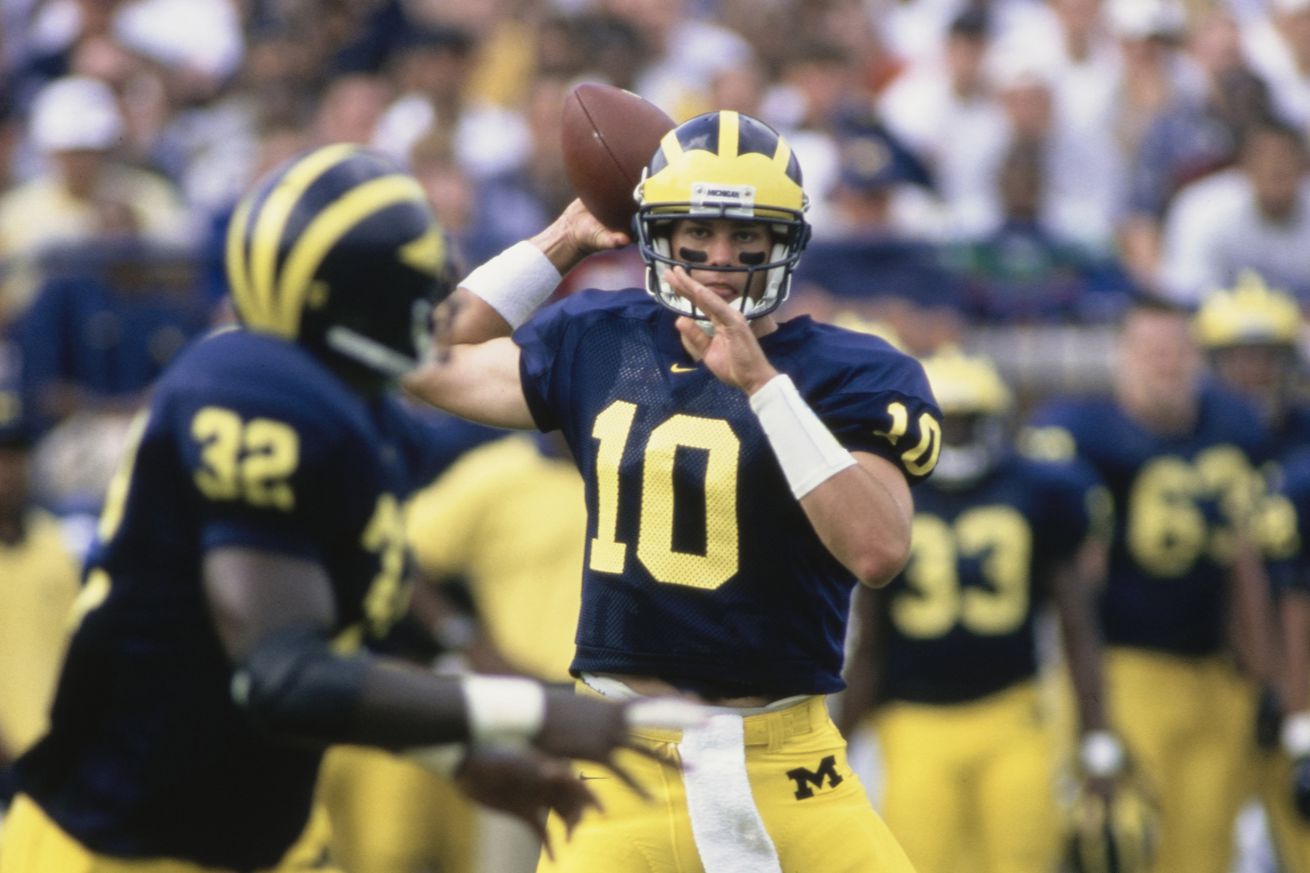
A deep dive into Tom Brady’s underrated Michigan career, revisiting his battles with Drew Henson, big-game performances, and how he quietly became one of the most successful QBs in Wolverine history:
Welcome to Michigan Musings! Every Monday (at least until the start of football season) this will serve as your prime source for all things Michigan Wolverines ; a weekly digest featuring thoughts and commentary on (mostly) the top stories from the week that was. Similar to a newsletter (Brewsletter?), this will feature an assortment of stories and opinions from football to basketball to hockey to pop culture and everything in between.
Grab a cup of coffee, sit back, and let’s dive in.
A Michigan Tom Brady Retrospective
As one does, I was sitting at a bar with the fellas recently and talking ball. Honestly, it doesn’t get much better than hanging out with friends and naming great maize and blue-clad warriors from the past. Especially in the summer.
From running backs to defensive backs to offensive linemen, Michigan offers a rich rolodex to choose from. However, one position is often going to encounter an obvious and predictable interjection: quarterback.
The quarterback position at Michigan does not have the Heisman history of other programs. Or even the crazy stats to ‘wow’ the neutral fan. The program record for single-season passing yards is 3,331, and the record for touchdowns is an embarrassingly low 25. Roughly 15-20 quarterbacks at other schools surpass those numbers annually. But that doesn’t mean the position has been devoid of talent since 1879.
Michigan had two quarterbacks, Rick Leach and Dennis Franklin, finish in the top 10 of the Heisman voting in the 70s (Leach in two different seasons). Jim Harbaugh finished in the top three in 1986 and posted a 21-3-1 record in his final two seasons. Elvis Grbac was a powerhouse, two-time unanimous first-team All-Big Ten selection in the early ‘90s, and the turn of the century saw John Navarre and Chad Henne rewrite the record books with starting tenures resembling presidential terms.
Denard Robinson’s legs kept Michigan afloat during one of the darkest stretches in program history as he finished sixth in the Heisman in 2010, and most recently, J.J. McCarthy led Michigan to a national championship while finishing 10th for the prestigious bronze statue.
But once any fan mentions Tom Brady, expect an uninformed, or green & white/scarlet & grey-tinted outburst of, “Tom Brady was trash in college!” Albeit mostly spoken from people who were under the age of 10 or not even born when he played in Ann Arbor, it’s time to put this misnomer to bed.
After answering head coach Lloyd Carr’s challenge and opting not to transfer during his first three years, Tom Brady seized his opportunity at Michigan in 1998. Brady held off generational recruit Drew Henson to become the starting quarterback (although Brady would occasionally split snaps with Henson, appearing in seven games) and posted a 10-3 record in the shadow of a national championship season.
Brady completed 62 percent of his passes for 2,427 yards, 14 touchdowns, and 10 interceptions. Not eye-popping, but the first-year starter helped command a balanced offense led by running back Anthony Thomas and 900-yard receiver Tai Streets.
Michigan dominated a tough Penn State team, 27-0; handed Wisconsin’s Barry Alvarez and Ron Dayne their lone loss of the season by a sizable 17 points; smoked Houston Nutt’s Arkansas team 45-31 in the Citrus Bowl. When the dust settled, Michigan didn’t repeat, but finished a respectable No. 12 in the final polls.
Furthermore, Michigan’s only three losses — two of which came in the first two weeks of the season — came to teams that would finish the ‘98 campaign ranked. And the following season, Brady and the team were even better.
Michigan’s historic 2023 season saw the team go undefeated and beat five teams that finished the season ranked. No team in modern program history (since 1969) has ever beaten that many quality opponents who would ultimately finish in the top 25. The 1997, 2006, 1985, and 2016 teams, among a handful of others, would beat three in a season. However, the team that came the closest was the 1999 team with four wins.
The ‘99 team was special. Led by Brady, the Wolverines beat rivals Notre Dame and Ohio State ; knocked off Wisconsin and Penn State on the road, both of whom would finish ranked inside the top 11; beat a ranked Spoilermakers team, and defeated a top-10 Alabama team in one of the most thrilling Orange Bowls of all time.
Brady’s passing yards dipped slightly as he split more time with Henson over the first half of the season, but he still threw two more touchdowns and four fewer interceptions overall. More impressively, once he was named the full-time, full-game starter, Brady led a fourth-quarter comeback in Happy Valley, a game-winning drive against Ohio State, and helped Michigan overcome two 14-point deficits in an overtime victory against the Crimson Tide, a game in which Brady threw for 369 yards, four touchdowns, and zero interceptions to cap his collegiate career.
Michigan finished the season ranked No. 5 (curiously, one spot behind Wisconsin with an identical record, worse losses, and a home loss to the other) with the only blemishes coming in back-to-back weeks in October with losses to Michigan State and Illinois, two teams that would also finish the season ranked. The Wolverines would not finish fifth or higher in any season again until 2021.
Brady finished his career at Michigan with a 20-5 record, two bowl wins, and led two teams that never finished worse than twelfth in the country. Despite constant doubt about his abilities and splitting time with the supposed future of the program, Brady persisted to finish his career as one of the most successful quarterbacks in program history.
The next time someone questions Brady’s college accolades, the next round is on them.
